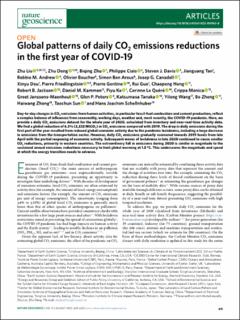| dc.contributor.author | Liu, Zhu | |
| dc.contributor.author | Deng, Zhu | |
| dc.contributor.author | Zhu, Biqing | |
| dc.contributor.author | Ciais, Philippe | |
| dc.contributor.author | Davis, Steven J. | |
| dc.contributor.author | Tan, Jianguang | |
| dc.contributor.author | Andrew, Robbie | |
| dc.contributor.author | Boucher, Olivier | |
| dc.contributor.author | Arous, Simon Ben | |
| dc.contributor.author | Canadell, Josep G. | |
| dc.contributor.author | Dou, Xinyu | |
| dc.contributor.author | Friedlingstein, Pierre | |
| dc.contributor.author | Gentine, Pierre | |
| dc.contributor.author | Guo, Rui | |
| dc.contributor.author | Hong, Chaopeng | |
| dc.contributor.author | Jackson, Robert B. | |
| dc.contributor.author | Kammen, Daniel M. | |
| dc.contributor.author | Ke, Piyu | |
| dc.contributor.author | Le Quéré, Corinne | |
| dc.contributor.author | Monica, Crippa | |
| dc.contributor.author | Janssens-Maenhout, Greet | |
| dc.contributor.author | Peters, Glen Philip | |
| dc.contributor.author | Tanaka, Katsumasa | |
| dc.contributor.author | Wang, Yilong | |
| dc.contributor.author | Zheng, Bo | |
| dc.contributor.author | Zhong, Haiwang | |
| dc.contributor.author | Sun, Taochun | |
| dc.contributor.author | Schellnhuber, Hans Joachim | |
| dc.date.accessioned | 2024-02-06T12:45:39Z | |
| dc.date.available | 2024-02-06T12:45:39Z | |
| dc.date.created | 2022-08-26T09:41:59Z | |
| dc.date.issued | 2022 | |
| dc.identifier.citation | Nature Geoscience. 2022, . | en_US |
| dc.identifier.issn | 1752-0894 | |
| dc.identifier.uri | https://hdl.handle.net/11250/3115932 | |
| dc.description.abstract | Day-to-day changes in CO2 emissions from human activities, in particular fossil-fuel combustion and cement production, reflect a complex balance of influences from seasonality, working days, weather and, most recently, the COVID-19 pandemic. Here, we provide a daily CO2 emissions dataset for the whole year of 2020, calculated from inventory and near-real-time activity data. We find a global reduction of 6.3% (2,232 MtCO2) in CO2 emissions compared with 2019. The drop in daily emissions during the first part of the year resulted from reduced global economic activity due to the pandemic lockdowns, including a large decrease in emissions from the transportation sector. However, daily CO2 emissions gradually recovered towards 2019 levels from late April with the partial reopening of economic activity. Subsequent waves of lockdowns in late 2020 continued to cause smaller CO2 reductions, primarily in western countries. The extraordinary fall in emissions during 2020 is similar in magnitude to the sustained annual emissions reductions necessary to limit global warming at 1.5 °C. This underscores the magnitude and speed at which the energy transition needs to advance. | en_US |
| dc.language.iso | eng | en_US |
| dc.publisher | Springer Nature ltd | en_US |
| dc.rights | Navngivelse 4.0 Internasjonal | * |
| dc.rights.uri | http://creativecommons.org/licenses/by/4.0/deed.no | * |
| dc.title | Global patterns of daily CO2 emissions reductions in the first year of COVID-19 | en_US |
| dc.title.alternative | Global patterns of daily CO2 emissions reductions in the first year of COVID-19 | en_US |
| dc.type | Peer reviewed | en_US |
| dc.type | Journal article | en_US |
| dc.description.version | publishedVersion | en_US |
| dc.source.pagenumber | 0 | en_US |
| dc.source.journal | Nature Geoscience | en_US |
| dc.identifier.doi | 10.1038/s41561-022-00965-8 | |
| dc.identifier.cristin | 2046218 | |
| dc.relation.project | EC/H2020/776810 | en_US |
| dc.relation.project | EC/H2020/820846 | en_US |
| dc.relation.project | EC/H2020/958927 | en_US |
| dc.relation.project | EC/H2020/821003 | en_US |
| cristin.ispublished | true | |
| cristin.fulltext | original | |
| cristin.qualitycode | 2 | |

